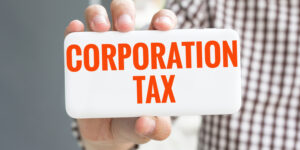Capital Gains Tax (CGT) is a tax on the profit (gains) made on the disposal of certain valuable assets such as property, shares, works of art, and business assets. If you operate a small business as a sole trader or partnership, or own shares in a limited company, you may be subject to CGT under certain circumstances.
This post explains how Capital Gains Tax works when you dispose of all or part of a business asset, including company shares. We discuss when CGT applies, how much you will pay, and the different allowances and reliefs you can claim.
What is Capital Gains Tax and when does it apply?
Capital Gains Tax is a type of tax that individuals and certain business owners have to pay when they sell or ‘dispose of’ particular assets that have increased in value.
You pay tax on the gain you make, rather than the money you receive. Generally, the gain is the difference between the price that you originally paid for the asset and the price that you sold it for.
For example, if you buy a commercial property for £250,000 and later sell it for £350,000, you will pay Capital Gains Tax on the £100,000 gain, not the full sale price.
Capital Gains Tax (CGT) may also apply if you give away an asset or sell it for less than it is worth. In these situations, the tax charge is usually based on the market value of the asset at the time of its disposal.
Who pays Capital Gains Tax?
Capital Gains Tax is payable by private individuals, self-employed sole traders and partners in business partnerships, company owners, trustees, and personal representatives of deceased persons.
Limited companies are not subject to CGT. Instead, they pay Corporation Tax on any profit generated from the sale of their business assets.
However, if you sell all or part of your company, you may have to pay Capital Gains Tax as an individual on the personal profit you make from the sale, as well as any business assets that you retain.
Disposing of business assets
Business assets are tangible and intangible possessions that create value for a business. The types of business assets that may be subject to CGT upon their disposal include:
- land and buildings
- fixtures and fittings
- plant, machinery, and vehicles
- company shares or bonds that are not in an Individual Savings Account (ISA) or Personal Equity Plan (PEP)
- registered trade marks
- customer lists
- goodwill (i.e. the business brand, reputation, and customer base)
These are referred to as ‘chargeable assets’. For Capital Gains Tax purposes, a disposal of any such chargeable asset takes place if you:
- sell it for more than the price you paid for it
- sell it for less than it is worth
- give it away as a gift or transfer it to someone else
- trade it for something else
- receive compensation for it (e.g. from an insurance payout)
Capital Gains Tax does not usually apply to business assets that you give away to charity or those that you give or sell to your spouse or civil partner. This is because no gain or loss is deemed to take place in these circumstances. However, there are exceptions, which we discuss later in the post.
Capital Gains Tax when selling your business
Whether you are a sole trader, a partner in a business partnership, or the owner of a limited company, you may have to pay Capital Gains Tax when selling all or part of your business.
Sole trader or business partnership
If you sell a sole trader business or a partnership, you will pay CGT on any ‘capital gain’ that you make from selling the business. This gain may be the money that you get from the sale, as well as any business assets that you keep for yourself.
Limited company
If you sell a limited company (or your shareholdings in a company), you will pay CGT as an individual shareholder on any personal ‘capital gain’ you receive from the sale. This can include:
- the profit you make from selling the business as a whole (i.e. its trade, assets, and all shareholdings combined)
- money you get for the sale of your shareholding
- any assets of the company that you keep for yourself
The amount of Capital Gains Tax that you pay on the disposal of shares or the business as a whole is based on the difference between what you paid for the shares or the company (or their value when you started the business) and what you sold them for.
If you sell the entire business as a going concern, rather than simply structuring the sale as a disposal of shareholdings, the company may also have to pay Corporation Tax on the sale of its business assets before the proceeds are distributed to shareholders.
Therefore, when selling a company, it’s normally better from a tax perspective to structure the sale as a disposal of shares rather than an asset sale. Otherwise, the proceeds may be liable to both Corporation Tax and Capital Gains Tax.
How much Capital Gains Tax will I pay as a small business owner?
When you dispose of a business asset or sell your business, you need to work out your gain to determine whether it’s liable to Capital Gains Tax and, if so, how much.
You won’t pay CGT on any gains in a tax year that are within the Annual Exempt Amount (your tax-free allowance for CGT). The tax-free allowance for the 2025/26 tax year is £3,000 (or £1,500 for trusts).
Above the Annual Exempt Amount, the rate of CGT you pay will depend on your Income Tax band and the type of disposal.
If you are a basic-rate taxpayer and your gains are within the basic Income Tax band, you will pay:
- 18% CGT on gains from chargeable assets (other than residential property and carried interest)
- 18% CGT on gains from residential property
- 32% CGT on gains from carried interest if you manage an investment fund
If you are a higher-rate or additional-rate taxpayer (or some or all of your gains exceed the basic Income Tax band) you will pay:
- 24% CGT on gains from chargeable assets (other than residential property and carried interest)
- 24% CGT on gains from residential property
- 32% CGT on gains from carried interest
Your capital gain counts toward your total taxable income for the year when you are working out your tax bracket. Therefore, a substantial gain could push your total earnings for the year above the basic-rate threshold (£50,270 for the 2025/26 tax year). You need to bear this in mind when you’re working out your tax liability.
Capital Gains Tax on the disposal of residential property will apply if you do not meet the criteria for Private Residence Relief. For example, if part of your home is used exclusively by your business, or you sell an investment property.
Capital Gains Tax on gifts
You won’t have to pay CGT on a business asset that you give away to charity. However, the disposal may be subject to tax if you sell the asset to charity for more than you paid for it and less than market value.
Similarly, if you give or sell any business assets to your spouse or civil partner, you won’t pay Capital Gains Tax on the disposal unless:
- you are separated and didn’t live together at all in that particular tax year, or
- you gave them the goods to sell through their own business
You might be able to delay or pay less Capital Gains Tax by claiming certain reliefs or costs related to the asset. We discuss these in more detail below.
Working out your capital gain
When you sell or dispose of a business asset, the gain that is subject to Capital Gains Tax is normally the difference between the price that you paid for the asset (or its value when you first owned it) and the price that you sold it for.
However, you must use the market value of the asset to work out the gain if you:
- give it away to someone other than your spouse or civil partner or a charity
- sell it for less than it is worth
- inherited the asset and do not know the Inheritance Tax value
- have owned it since before April 1982
If you sell or dispose of an asset that was given to you and you claimed Gift Hold-Over Relief, you must use the original purchase price of the asset to calculate your gain. If you bought it for less than it was worth, you must use the amount that you paid for it.
You can ask HMRC’s Shares and Assets Valuations (SAV) team to check your valuation. To do so, you need to complete a ‘Post-transaction valuation check for capital gains’ form after the disposal takes place.
- Tax implications of transferring shares to your spouse or partner
- Can shares be transferred to children?
To work out your total taxable gains and tax liability for the year, you need to combine the gains from each business asset and deduct any allowable losses, costs, and tax relief. The overall gains above the Annual Exempt Amount will then be subject to Capital Gains Tax.
If your total gains are under your tax-free allowance for the year, you won’t have to pay any CGT. However, you will still need to report your gains to HMRC if both of the following apply:
- the total amount that you sold the assets for was more than four times your CGT allowance
- you are registered for Self Assessment
The rules are different in you need to report a loss on a chargeable asset (more on this below).
Reducing your Capital Gains Tax liability
Depending on the asset and type of disposal, you may be able to reduce your Capital Gains Tax liability by deducting certain costs and expenses, offsetting losses, and claiming tax reliefs. These are in addition to your annual tax-free allowance for CGT.
Deducting costs
If you incur certain costs or expenses as a result of buying, improving, or selling a business asset, you can deduct these from the capital gain you make.
The costs that you can deduct include:
- incidental fees such as acquisition, valuation, advertising, or disposal costs
- making improvements to an asset (except normal maintenance and repairs)
- Stamp Duty Land Tax and Value Added Tax (VAT), unless you are reclaiming the VAT
Costs that you cannot deduct include:
- interest on a loan that you used to buy the asset
- any costs that you can claim as business expenses
If you are unsure about deducting certain costs or expenses, you can contact HMRC for clarification.
Reporting a loss
If you make a loss on any chargeable assets, you can reduce your overall taxable gains by claiming for ‘allowable losses’ in your Self Assessment tax return.
You can deduct allowable losses from the total gains you make in the same tax year. However, you can also claim losses up to four years after the end of the tax year in which you disposed of the asset.
This means that you can deduct unused losses from previous tax years and carry forward any remaining allowable losses to future tax years, enabling you to make full use of your Annual Exempt Amount each year.
Claiming tax relief
You may also be able to reduce or delay your Capital Gains Tax liabilities on business assets if you are eligible for tax relief, such as:
Business Asset Disposal Relief (formerly Entrepreneurs’ Relief)
If you sell all or part of your business in the 2025/26 tax year, you may be able to pay a reduced rate of 14% Capital Gains Tax (rather than the normal rates) on any gains you make on qualifying business assets. Business Asset Disposal Relief (BADR) is available to:
- sole traders
- self-employed partners in a business partnership
- shareholders in a ‘personal company’
- trustees selling assets held in a trust
The BADR rate will increase to 18% for disposals made on or after 6 April 2026.
To qualify for BADR as a sole trader or partner, you must own the business for a minimum of two years up to the date on which you sell the business.
However, if you are selling shares in your company, both of the following must apply for at least two years up to the date on which you sell your shares:
- you are an employee, director, or company secretary of the company (or another firm in the same group)
- the company’s main business activities are in trading (as opposed to non-trading activities like investment), or it is the holding company of a trading group
Unless the shares are from an Enterprise Management Incentive (EMI), the business must also be a ‘personal company’ for at least two years before the disposal takes place.
This means that you must hold at least 5% of the shares and voting rights in the company. Additionally, you must be entitled to:
- at least 5% of distributable company profits and net assets on winding up the company, or
- at least 5% of disposal proceeds if the company is sold
If your shareholdings fall below 5% because the company issued more shares, you may still be eligible for this relief if you elect to be treated as if you had sold and re-purchased the shares immediately before the new shares were issued. Doing so will create a gain on which you can claim BADR.
Business Asset Rollover Relief
If you dispose of a business asset and use all or part of the gains to replace it or buy other business assets, you can delay paying the CGT that you owe until you dispose of the new assets. To be eligible for Business Asset Rollover Relief, the new assets must be purchased within three years of disposing of the old ones (or up to one year before).
Incorporation Relief
If you operate as a sole trader or business partnership and you decide to set up a limited company, you may be able to claim Incorporation Relief if you transfer your business assets (excluding cash) to the company in exchange for shares in that company. This will allow you to delay paying CGT on those assets.
Gift Hold-Over Relief
If you give away business assets (including some types of shares) or dispose of them for less than they are worth, you may be able to claim Gift Hold-Over Relief. If eligible, you won’t pay any Capital Gains Tax on the disposal. Instead, the recipient will be subject to CGT if they later dispose of those assets.
Disincorporation relief
If you change your business structure from a limited company to a sole trader or partnership and acquire the company’s business assets, it may be possible to claim Disincorporation Relief. However, CGT may apply if you later dispose of those assets.
Private Residence Relief
Private Residence Relief automatically applies if you sell or dispose of your primary residence, as long as:
- it has been your main home for the entire duration of ownership
- no part of it is used solely for business purposes.
However, if you use any part of your home exclusively for business purposes, such as a home office or studio space, you will have to pay CGT on that part of the property when you sell it.
Reporting and Paying Capital Gains Tax to HMRC
Capital Gains Tax must be reported and paid to HMRC. You won’t receive a CGT bill – it is your responsibility to work out and report your gains (or losses) and tax liability. You can do this in one of two ways:
- using HMRC’s ‘real time’ Capital Gains Tax service (UK residents only)
- in your Self Assessment tax return
If you are in a business partnership, you will need to work out and report your share of each gain or loss. The nominated partner must also complete form SA803 on behalf of the partnership itself.
Whichever way you choose to report and pay Capital Gains Tax, you must ensure that you have:
- the date on which you took ownership and disposed of the business asset
- details of the price you paid for the asset and how much you sold it for (or its market value)
- any additional information that may be relevant, such as deductible costs, allowable losses, and tax reliefs
- calculations for the capital gains or losses that you are reporting
Once you have reported your gains to HMRC, you will receive a letter or email containing your 14-character CGT payment reference number that starts with ‘X’.
You must use this number when paying your CGT using HMRC’s online tax payment service, through online banking, or by cheque. However, if you reported your gains in your Self Assessment tax return, you will pay the tax you owe as part of your Self Assessment tax bill.
Records you need to keep
The records you will need to keep to work out your gains and report your CGT liability include bills, invoices, and receipts showing:
- how much you paid for the asset
- additional costs related to buying, improving, or disposing of it
- tax reliefs
- how much you received for the asset
- contracts relating to the purchase or sale of the asset
- copies of valuations
You must keep these records for at least five years after the Self Assessment deadline.
Thanks for reading
Whether you run your business as a sole trader, partnership, or limited company, there may come a time when you have to report and pay Capital Gains Tax on the disposal of business assets.
The rules and regulations can be incredibly complex, particularly when selling a business, so it’s worthwhile seeking professional advice from an experienced and reputable accountant.
If you have any questions about this post, please leave a comment below. For more small business news and advice, visit the 1st Formations Blog
Please note that the information provided in this article is for general informational purposes only and does not constitute legal, tax, or professional advice. While our aim is that the content is accurate and up to date, it should not be relied upon as a substitute for tailored advice from qualified professionals. We strongly recommend that you seek independent legal and tax advice specific to your circumstances before acting on any information contained in this article. We accept no responsibility or liability for any loss or damage that may result from your reliance on the information provided in this article. Use of the information contained in this article is entirely at your own risk.















Join The Discussion
Comments (6)
Dear Team,
This is a great article. However, it does not, as indeed the HMRC web site and all other articles on this complicated subject do not, clarify whether or not the BADR is on the capital gain which is replacing Corporation Tax on income as it is a gain or if it is relevant on disposal after Corporation Tax is paid.
In other words, is it before or after Corporation Tax or based upon the receipt as a “gain” which replaces corporation tax where goodwill is “capitalised” so subject only to CGT ?
One would assume it to be one tax as a gain not tax as income and the again as a gain on disposal.I know it is a bit picky but your response would clarify a great article generically.
Thank you for your comment, Laurence. Capital Gains Tax and Corporation Tax are different concepts. This article relates to Capital Gains Tax payable by business owners on the sale of their personally owned business assets, e.g. most commonly sole trader businesses or shares in companies.
Corporation Tax will be incurred by a company on their business profits. Capital Gains Tax will then be incurred at the point at which an individual disposes of a capital asset for a gain. Therefore the two taxes can both be incurred, as they are taxing separate taxable entities and profits/gains.
If a company disposes of assets for a profit, it will incur corporation tax on the gains as opposed to capital gains tax.
Unfortunately, I’m unclear what you mean with regards to impact of the capitalisation of goodwill, but if you can clarify the question then we would be happy to look into this further.
Kind regards,
The 1st Formations Team
Hi – so if you are a sole director of a Plc and a basic rate tax payer and you sell that business for £25300 your CGT allowance is £15300 and you pay 10% CGT on the remaining £10000?
Thank you for your message, Paul. Can we clarify if you mean PLC, as Public Limited Companies are required to have a minimum of two directors?
Kind regards,
The 1st Formations Team
Hi John,
We have our business up for sale and it could fetch £475’000.
The business is a guest house and we initially paid £ 35’000 in 1983.
We raised money on the property of about £ 50’000 to do work on it and as deposit for us to buy next door for our family to live in. The property is now paid for.
What sort of Capital Gains cost are we likely to incur please. Kind Regards Janet
Thanks for the question Janet.
We’re very sorry but we can’t answer questions on a specific scenario such as this.
Sorry we couldn’t be of more use.
Best regards,
The 1st Formations Team